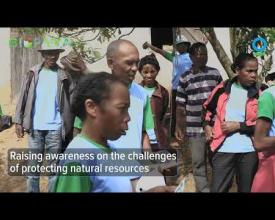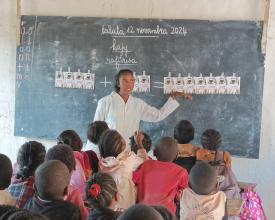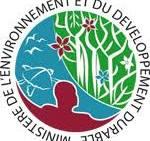
“CAZ4Lemur” Capacity building and joint action with the local community in Madagascar

This solution is set in Madagascar’s Ankeniheny-Zahamena Corridor (CAZ), a globally recognized biodiversity hotspot that shelters numerous endangered and vulnerable lemur species. The project site, Fierenana—a rural commune in the western CAZ—is designated as an Alliance for Zero Extinction (AZE) site, uniquely identified as the only place on Earth where at least one critically endangered species survives in its natural habitat.
Despite this ecological importance, conservation efforts face major challenges, including habitat degradation, weak law enforcement, and limited local capacity. The solution, implemented through the “CAZ4Lemurs” project with support from BIOPAMA, addresses these issues by empowering local community-based organizations (COBAs) to manage forest buffer zones and monitor lemur populations. The initiative has enhanced patroller skills and fostered law enforcement. Environmental education is being integrated into school curricula, while legal training strengthens enforcement, and promotes livelihoods.
Context
Challenges addressed
Conservation in the CAZ Protected Area, especially in Fierenana, faces several persistent challenges. Patrollers often lack sufficient monitoring skills, and law enforcement remains weak, with many offenses going unpunished or resolved with minimal consequences, undermining community trust. Biodiversity threats include selective logging, slash-and-burn agriculture, traditional mining, and lemur trapping. Cultural practices and low education levels hinder understanding of conservation laws, which are often written in complex language. COBAs, mainly composed of farmers, have limited time for patrols, and require repeated coaching to master monitoring tools. Monitoring is further disrupted by vandalism of transect markers. Environmental education is scarcely integrated into the national curriculum, and despite proximity to the forest, local knowledge and appreciation of biodiversity remain low. These issues collectively weaken conservation efforts and community engagement.
Location
Process
Summary of the process
The success of the CAZ4Lemur project lies in the strategic integration of its three core components. Empowering grassroots communities (Building Block 1) through COBAs creates a foundation for local ownership of conservation efforts. These community members, some of whom serve as patrollers, are directly involved in monitoring lemurs and protecting habitats. Their work is reinforced by capacity building in environmental law (Building Block 2), which equips COBAs, police, and judicial officers with the legal tools to respond to environmental offenses, ensuring that field observations lead to meaningful enforcement. Meanwhile, environmental education in schools (Building Block 3) nurtures a conservation ethic in the next generation, creating long-term cultural change. These elements are interdependent: community action informs legal processes, legal support protects community efforts, and education sustains both by embedding conservation values early on. Together, they form a cohesive system that strengthens conservation outcomes.
Building Blocks
Empowering Grassroots Communities for Forest Patrol and Lemur Conservation
To strengthen the capacity of local patrollers in the Fierenana forest, a targeted training program was implemented to support grassroots communities with practical tools and knowledge for biodiversity monitoring. This initiative focused on lemur conservation and involved both theoretical and field-based instruction. Patrollers were trained in responsible forest navigation, emphasizing the importance of silence, attentiveness to visual and auditory cues, and appropriate behavior to minimize disturbance to wildlife.
A key component of the training was the introduction of four standardized data collection sheets. These tools guided patrollers in documenting transect routes, recording sightings of target species, identifying threats, and noting microhabitat conditions. The transect sheet helped define patrol routes, which followed existing forest trails and were marked every 25 meters with blue flags to aid in spatial referencing. Transects ranged from 1,000 to 4,500 meters and were selected to maximize forest coverage while avoiding deforested areas. To prevent overlap in observations, adjacent transects were spaced at least 250 meters apart.
During patrols, patrollers walked at a steady pace of 1 km/h, recording all visible lemurs along the transect. Observations included species identification, group size, age categories, and, when possible, sex. For each group, the patroller estimated distances to aid in future density calculations. Only visual sightings were counted to avoid duplication from vocalizations. In parallel, patrollers documented threats such as traps, logging, fires, and slash-and-burn agriculture, attempting to quantify their extent in terms of number, volume, or area. Any threats observed were flagged with red markers and dated to avoid repeated reporting in future surveys.
Patrollers also learned to use GPS devices to locate transect starting points and to ensure consistent data collection. Surveys were ideally conducted at the same time each day, starting no later than 7:30 AM, to maintain comparability. Observations of non-target species and off-transect sightings were also recorded to provide a broader ecological context. Each of the nine local community-based organizations (COBAs) was responsible for monitoring two to three transects per month, fostering local ownership and continuity in conservation efforts.
This building block demonstrates how structured training, simple tools, and community engagement can be effectively combined to support conservation goals. It offers a replicable model for other forest ecosystems and species monitoring programs.
Enabling factors
In the commune of Fierenana, there already exists a strong foundation for community-based conservation. The local Community-Based Organizations (COBAs) have been actively engaged in protecting the CAZ Forest in Madagascar, which involves participation from both men and women from the local communities, who are committed to environmental stewardship.
Through a process known as “Management Transfer,” the Ministry of the Environment delegates the management of specific forest areas—particularly buffer zones of the CAZ—to these COBAs. These management contracts are reviewed and renewed every three to five years, depending on performance and compliance. Each COBA operates under a formal structure, including a governing board, internal regulations, and a general assembly, ensuring transparency and accountability.
Currently, at least nine COBAs operate within Fierenana, collectively overseeing a forest area of approximately 7,100 hectares. These groups include around 478 members, with a subset designated as patrollers—individuals physically capable of conducting regular biodiversity monitoring and threat assessments, particularly for lemur habitats. Each COBA is based in a fokontany, the smallest administrative unit in Madagascar, which helps ensure localized engagement and oversight.
To streamline coordination and strengthen collaboration with Conservation International (CI), these COBAs were unified under a single umbrella organization: the Vahitriniala Federation. This federation serves as the primary point of contact for CI throughout the BIOPAMA project and facilitated more efficient contracting and project implementation.
Local governance structures further reinforce these efforts. The commune is led by a mayor, supported by deputies, municipal staff, and council members. At the fokontany level, the Fokontany Chief played a key administrative role, while the Tangalamena—the traditional leader—provides cultural legitimacy and often endorses major decisions. This alignment between formal institutions and traditional authorities helped to create a favorable environment for conservation initiatives, ensuring both administrative support and community buy-in.
Lesson learned
The rural commune of Fierenana has shown that environmental awareness is most effectively spread when integrated into all types of community gatherings. Embedding conservation messages into routine meetings—especially those led by local authorities—significantly enhances the reach and impact of awareness campaigns.
Effective communication also depends heavily on the credibility and conviction of the facilitator. When facilitators are genuinely committed and transparent in their approach, they are more likely to gain the trust and cooperation of community members.
However, challenges remain. In some cases, individuals have misused the name of a COBA to gain access to forest areas under the pretense of conservation, only to later convert the land for agricultural use. This highlights the importance of rigorous oversight. The Ministry of the Environment must ensure consistent monitoring of the management transfer process, while COBAs must strictly adhere to the terms outlined in their management agreements. These agreements, co-signed by the Ministry and the COBA president, are essential tools for accountability and must be respected in both letter and spirit.
Another key lesson relates to the confidentiality of patrol schedules. To prevent information leaks that could alert offenders, patrol dates should be communicated discreetly within the team. When offenders are aware of patrol timings, they may avoid detection, undermining conservation efforts. Maintaining operational secrecy is therefore critical to the effectiveness of forest monitoring activities.
Capacity Building in Environmental Law
Due to a lack of knowledge and/or application of existing laws related to biodiversity conservation efforts in the CAZ region, the CAZ4Lemur Project focused on building legal awareness and capacity among key stakeholders. This included training members of COBAs, judicial police officers (mayors, forestry agents, gendarmes), and senior judicial officers (judges) on environmental and protected area legislation.
Through participatory workshops in Fierenana, participants learned how to identify, report, and follow up on environmental offenses. Training covered legal responsibilities, reporting procedures, and the use of tools like the ALOE app (Accès aux LOis Environnementales), which provides digital access to environmental laws. Practical simulations and case studies reinforced learning, and participants were introduced to a free hotline (#512) for reporting offenses or seeking legal guidance.
The project benefited from strong collaboration with the Moramanga CIREF (representative of the Ministry in charge of the environment and sustainable development at the District level), whose technical officers co-led sessions on biodiversity law and protected area management. Monthly reports from patrollers to CIREF include biodiversity data and threats, though delays in legal action remained a challenge. To address this, COBAs proposed applying “Dina”, a traditional community regulation associated with community self-governance of natural resources in Malagasy society—for minor offenses—allowing for immediate, locally accepted sanctions. This approach, documented in a jointly signed responsibility charter, helps maintain order while reducing administrative delays. Serious offenses were escalated to CIREF or the courts. For high-risk missions, collaboration with military or gendarmerie units was recommended to ensure safety and authority.
Enabling factors
The success of this initiative was supported by several enabling factors. First, participants were given access to environmental law resources in both digital and printed formats, including the ALOE app, which allowed them to consult legal texts on mobile devices and computers. Second, the workshops fostered strong multi-stakeholder engagement by bringing together COBAs, women’s organizations, patrollers, local authorities, and law enforcement, encouraging collaboration and shared understanding. Finally, the involvement of CIREF in both training delivery and project oversight ensured technical accuracy and alignment with national conservation priorities, reinforcing the credibility and effectiveness of the initiative.
Lesson learned
Several important lessons emerged from the implementation of this solution. First, the use of local enforcement mechanisms such as the “Dina” proved essential for addressing minor offenses quickly and in a way that is accepted by the community, thereby reducing the burden on formal legal institutions. However, delays in legal action from authorities were found to undermine the motivation of patrollers and community members, highlighting the need for timely and consistent enforcement. Lastly, for high-risk missions, the involvement of military or gendarmerie units was seen as crucial to ensure the safety of patrollers and to reinforce the legitimacy of enforcement actions.
Integrating Lemur Conservation into Education and Community Outreach through Schools and Festivals
Learning about the importance of Conservation has no age limit, and schools are a powerful entry point for long-term impact. In Fierenana, the BIOPAMA Project worked with 27 public and private primary and secondary schools to integrate lemur conservation into teaching practices. Through a series of workshops, 144 teachers were trained to incorporate environmental protection and sustainable resource management into their curricula, with a special focus on lemurs. CI also collaborated with the Ministry of National Education to embed lemur conservation into the national environmental education framework.
A highlight of this initiative was also the use of public events to raise awareness about lemur conservation. This took place through the annual Lemur Festival, organized as part of the CAZ4Lemur project. The first two editions attracted 1,200 and 1,500 participants respectively. Led by the mayor and supported by local authorities, COBAs, school representatives, and community members, the festival featured a carnival, official ceremonies, and creative activities such as poetry, theatre, and dance. Children wore lemur masks, colored themed sheets, and participated in workshops. The slogan, “Varika: tsy fiompy, tsy fihinana, fa haingo ary mampaharitra ny ala” (“The lemur is not a pet, nor food, but a beauty that preserves the forest”), captured the spirit of the event. The festival concluded with a documentary screening on lemurs and environmental protection.
Complementary activities included law enforcement training for patrollers and pre/post-festival workshops for teachers.
Enabling factors
The success of this initiative was made possible through inclusive collaboration. The project partnered with the Ministry of National Education, specifically the Globe Program and the Directorate of Mass Education and Civics (DEMC), to develop educational modules on environmental conservation.
Fierenana’s 27 schools are supported by two ZAP (Administrative and Educational Zone) heads, who helped coordinate the cascade training model. Selected teachers were trained on lemur and habitat conservation and then tasked with training their peers. The CISCO office in Moramanga ensured alignment with national pedagogical standards. The project also worked alongside other NGOs and associations to reinforce conservation messaging across different platforms.
Lesson learned
Educational tools such as game cards, signs, coloring pages, and lemur photos proved highly effective in sparking students’ interest in nature. However, broader distribution of these materials is needed to ensure all teachers are equipped, especially when teaching schedules overlap.
Although environmental themes are officially part of the national curriculum, integrating lemur-specific content required thoughtful preparation of tailored teaching materials. Documentary screenings also proved impactful, drawing strong interest from both students and parents.
Finally, collaboration between teachers and patrollers during field visits or nature outings greatly enhanced mutual learning. Knowledge exchanges should flow both ways—between educators, patrollers, and families—to build a stronger, more informed conservation community.
Impacts
During the CAZ4Lemur project, the Fierenana community saw transformative impacts through capacity building and trainings, biodiversity monitoring and conservation, education and awareness-raising, as well as through improvements to livelihoods through sustainable agriculture.
Capacity Building and Trainings: Thirty-six patrollers were trained in biomonitoring, learning to track lemurs and threats across 22 forest transects. Their efforts led to the identification of 10 lemur species, including 1,030 individuals of three critically endangered species—Indri indri, Varecia variegata, and Propithecus diadema—with 143 juveniles, signaling a healthy ecosystem.
Biodiversity Monitoring and Conservation: Communities received 288 monitoring tools, and nine COBAs contributed to monthly data collection and reporting. Legal awareness grew through COAP training for 73 community leaders and environmental law sessions for police and ministry staff, supported by tools like the ALOE app.
Education and Awareness: 149 teachers were trained, reaching 4,688 students with 81 biodiversity-focused lesson plans. Lemur-themed teaching aids, school workshops, and a Lemur Festival deepened awareness.
Beneficiaries
The success of the CAZ4Lemur project lies in the strategic integration of its three core components, having community-based, local authorities, police, judicial officers, teachers from primary and secondary from private and public schools, as beneficiaries.
Global Biodiversity Framework (GBF)
Sustainable Development Goals
Story

This interview features Harison Randrianasolo, lead of the CAZ4Lemur project, and Andriamanana Emilson Harinambinina, head of ZAP Fierenana 1.
Since 2021, Conservation International (CI) has partnered with the Fierenana commune, which includes two ZAPs and 29 schools, serving over 4,200 students and 144 teachers. The CAZ4Lemur project focused on environmental education, especially lemur conservation, through teacher training, curriculum integration, and community events like lemur festivals.
Q: What were the main benefits of the BIOPAMA project?
A: The project had a strong impact, especially in boosting teachers’ skills in environmental education. Previously, conservation topics were rarely taught, but thanks to training from Conservation International and the Ministry of Education, teachers are now more confident and better prepared.
The training used a cascading model: CI trained a core group of teachers, who then trained others, reaching students and even their families. Lesson plans were developed with a focus on conservation and endangered lemurs, along with tools for early-grade teaching.
To reinforce learning, schools introduced sustainable practices like gardens, composting, waste management, and natural pesticides (ady gasy). These hands-on activities helped students apply what they learned and engage their families.
Social media, especially Facebook, supported collaboration and sharing among teachers, ZAP heads, and COBA members. In ZAP1 alone, over 55 teachers were trained, with the same approach extended to ZAP2—making it a truly community-wide effort.
Q: How was the message of conservation spread beyond the classroom?
A: Students applied what they learned in the field, especially in nearby forests. Community meetings and school events included conservation awareness. Lemur festivals featured art, performances, and speeches.
Q: What makes CAZ4Lemur unique?
A: It was the first initiative in the area to integrate environmental education across all schools. Teachers appreciated the inclusive and practical approach.
Q: What happens now that BIOPAMA is ending?
A: Conservation education will continue, as it’s now part of the national curriculum. Teachers are committed to using the tools and methods introduced by the project.
Q: Any final message or suggestions for the future?
A: We thank CI for their support and hope the project continues. Teachers are eager to participate in future training and receive more tools. Their dedication to conservation, even with busy schedules, is commendable.






